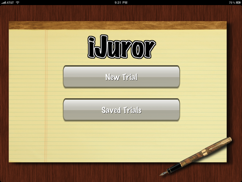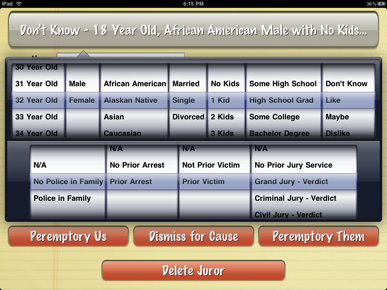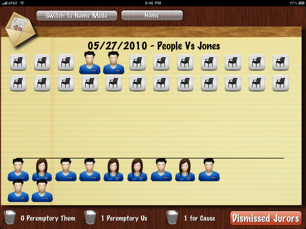
Few electronic devices have inspired the levels of techno-lust witnessed with Apple's iPad tablet. Selling nearly three and a half million of the devices in just the first quarter after its launch, the Apple iPad has also inspired a wave of applications ("apps") seeking to take advantage of the iPad's unique features. You may well be in that "let's wait and see" group that wants to know that the benefits go beyond its sleek and sexy look and feel. As an active litigator or trial consultant, the news that there is actually a jury selection app garnering media attention1 might just be enough to push you over the edge to the point of saying, "I need this….for, you know, my work!" But does iJuror live up to its promise to replace the paper grid and Post-it note? Based on my review, and some comparable experience with PC-based applications, the answer is 'not yet.' While the app has some noteworthy features, in the realistic conditions of oral voir dire, the app's functionality is not yet up to its potential.
Scott Falbo, an Amherst Massachusetts software designer, and spouse of Freid and Klawon attorney Renee Root, developed iJuror in response to his wife's complaints about the ad hoc nature of pen and paper tracking of juror information during voir dire. iJuror aims to solve that by placing all your notes on prospective jurors in an adaptable touch-screen environment. After installing the app, the user opens a new trial and is able to identify the number of jurors and alternates needed. At that point, the user sees a seating chart that can be altered to reflect the number of rows and columns in your courtroom layout. Selecting a given venire member (represented as empty chairs, until you enter their information), you are able to use a few finger flicks (Apple's "spinning wheel" style of selecting from a range of possible answers) to input ten basic demographic facts about your potential juror: age, gender, ethnicity, marital status, number of children, education, whether there are police officers in the family, prior arrest experience, prior victim experience, and prior jury experience. Then, using the on-screen keyboard, the user enters the venire-member's name, occupation, hometown and any other specific notes on the potential juror.

As information for each potential juror is entered, an avatar (aka cartoon image) of the juror appears, based on their gender. As voir dire proceeds, the user can add notes, provide an overall evaluation ('like,' 'maybe,' 'dislike') which adds a colored background to the juror (green, yellow, and red respectively), and can drag the avatars into categories for cause challenges and peremptory challenges.

What the app does well is to create a simple, visually-appealing layout for jury selection. At the same time, the limits of the app in its current version are many. The most important limit is that you cannot create your own variables to input and track the information that is of greatest value to you. The few built-in items reflect a clear bias toward the kind of information that you might have in a criminal trial where there is little to no oral voir dire, and it is easy to see that in most other situations, you will want to create numerous additional question and answer sets reflecting the needs of your case, the focus of oral voir dire, and any information from completed juror questionnaires. While that information can certainly be entered into the "notes" field, doing that just reduces the app to the same functionality as an unstructured Post-it.
The second limitation is an inability to score jurors on any worst-to-best scale that could be used to guide strikes and cause challenges. This is the true advantage of computer-aided voir dire note-tracking: the ability to systematically weight the data in a way that would be difficult or impossible using pencil and paper alone. Beyond the "like," "maybe," and "dislike" categories that iJuror offers, it would be useful to assign to each answer a valence ('helps them,' or 'helps us') and a value (1= 'a little,' and 10= 'a lot'). Doing that would produce a rough ranking that would at least direct the user's attention to the most strike-worthy members on the panel and truly provide a function that paper notes by themselves cannot provide.
The third limitation is more a feature of the iPad itself – the speed of data entry. While the "spinning wheel" method of entry is potentially faster than keyboard entry for items that fall in categories, users will inevitably need to key in a lot of information using a keyboard. For me, the iPad's on-screen keyboard is slow compared to a physical keyboard, and even compared to a Blackberry thumb-pad, making it hard to see how all the information could be entered in the small window of time permitted in many voir dire settings. Using the iPad's keyboard dock could alleviate that concern. There are also many other little things that could be changed in the app's execution, for example, the inability to 'undo' many actions, and the cartoonish look of the jurors themselves.
This is not to say, however, that there isn't a bright future for on-screen tracking of data during voir dire. When compared to current methods involving messy paper notes, offering minimal space for comments and only basic options for scoring, the task of keeping track of information during voir dire seems to belong on the screen. And the iPad, with its ability to turn-on instantly (instead of 'booting up'), a battery-life to last the full court day, and an intuitive user-interface, seems the perfect device. But as everyone who has prepared for and participated in jury selection knows, the task is very complex, and the development of an app that accounts for that complexity may take some time.
I expect that many consultants who frequently help to pick juries have explored options for keeping track of that information by computer. Based on Persuasion Strategies' own experience in working toward ways to use the PC during jury selection, I offer the following as a punch-list of what the ideal jury selection app should be able to do before it can justifiably replace pencil and paper methods:
Allow users to create any number of variables, including both customizable fixed or open-ended responses on each.
Maximize the number of questions that can be answered without the need for keyboard input.
Enable users to create a preliminary score for jurors based on their answers by supplying both a valence ('helps them,' or 'helps us') and a value (1= 'a little,' and 10= 'a lot') for each question.
Produce printed or email-able reports by juror and by question as well as an overall ranking of jurors, worst to best.
Allow reseating and movement of any number of jurors during selection in response to the judge's process.
Allow the user to 'flag' jurors for a possible strike or a hardship challenge.
Allow a 'reserve pool' of jurors to be created (e.g., all of those who mailed in the questionnaire), and then allow individuals to be drawn from that pool to reflect those who show up, or those who are randomly selected to be pulled into the box for questioning.
Take advantage of the iPad's wireless Bluetooth functionality by allowing multiple users to add information to the same file (e.g., 'you enter data for the first twenty-five panelists, I'll do the rest')
Over the past few years, the Persuasion Strategies group has been able to find our own solutions on the PC to meet all of those needs while providing reasonably fast data entry time permitting our proprietary program (we call it "JuryNotes") to be used in court, and it seems likely that other groups have their own tools as well. But touch-screen technology like the iPad's promises to make those solutions more effective, more elegant, and yes, more cool. For example, when members of a panel of thirty raise their hands to say "yes," to a given voir dire question, it would be natural to simply use your finger to touch the names for each potential juror raising their hand on a layout that matches where they are sitting in the box. For the task of voir dire, at least, it seems axiomatic that if it can be done on a PC, then it can be done better on an iPad.
But with iJuror, we aren't there yet. The ability to provide just ten fixed data points, and add some additional notes will just not be enough to replace the current Post-it and pencil approach, or to replace the PC systems that others are using. That said, for the price — $14.99 at the time of writing – it is well worth it for any attorney or consultant with an iPad to install iJuror, if only to play around with it… and to possibly see how we will track jury selection in the future.
Ken Broda-Bahm, Ph.D. is a litigation consultant based in Denver, Colorado with the firm Persuasion Strategies, a service of Holland & Hart LLP. He provides comprehensive services including trial messaging strategy, focus group and mock trial research, community attitude surveys, witness preparation, jury selection, mock bench trials and mock arbitrations. He has worked in a broad array of litigation types specializing in commercial, employment, construction and energy litigation. You can read more at www.persuasionstrategies.com.
Endnotes
1 For example, see Weiss, D.C. (2010, August 2nd) Avatars Help Litigators Select Juries in New iPad App. ABA Journal (Online); and Chandler, M. (2010, July 5th) Tech Tool Streamlines Jury-Selection Process. Buffalo Law Journal (Online).
If you can't customize the fields – then this is of NO use to any real trial lawyer.
Post it notes are archaic compared to the ipad…but the goal of voire dire is NOT to look cool – it's to pick the right jurors – and that is very case specific. age, gender, etc is far too basic….
There need to be detailed note fields that you coudl quickly enter and then see.. or the ability to customize fields for each case… customization woudl allow different types of lawyers to tailor the program to their needs… good idea..but far from ready for use in a real case..
Great article! I have just completed testing & review of iJuror and JuryTracker. The article will be published first on Law.com, then on my blog.
To follow updates, see http://trial-technology.blogspot.com/
I've posted a review of TrialPad and Evidence, two iPad apps for trial presentation, which also ran on Law.com.
Ken,
I think this piece very nicely lays out the promise and limitations of this app. I am definitely a consumer of "cool," so I'd like there to be a worthy iPad app for this purpose. Allow me, if I may, to add my own 2 cents worth of items to the wish list.
1) Allow the user to specify at the outset whether a "struck" or "sequential" system will be used for jury selection, which has big implications for when and how the data will be entered.
2) The program should automatically send up warning flags if patterns of strikes by either side seem in danger of violating Batson v. Kentucky.
3) A user should be able to indicate, for any prospective juror, when she has raised an objection during voir dire that she would like preserved for appeal. (Say, for instance, the judge has denied a motion to conduct a colloquy with a juror about exposure to pretrial publicity).
I am sure I could add more items to the list, but these are the first that popped into my head. I'll be tracking the updates of this app closely.